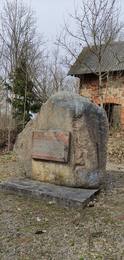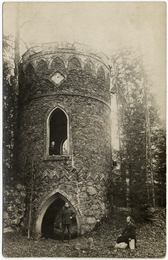The legacy of legionnaire Andrejs Apsītis in the Remte Forest
Evidence of World War II in the forests of Kurzeme is found from time to time, as enthusiasts of war relics and historical antiquities visit the forests and fields of Kurzeme with metal detectors very often. At the beginning of 2021, in the Remte side of Saldus municipality, various documents were found in an ammunition box buried in the forest, confirming belonging to the 19th Division of the Latvian Legion, as well as the personal belongings of a soldier. They had been lying in the ground for 76 years.
In early 2021, various documents proving belonging to the 19th Division of the Latvian Legion, as well as the personal belongings of soldier Andrejs Apsītis, were found in an ammunition box buried in the forest in the Remte area of Saldus municipality. They had been lying in the ground for 76 years.
Most likely, the box was buried in the Remte forest in early May 1945. At that time, the last battles in Kurzeme were taking place on this side and the headquarters of the 19th division of the Latvian Legion was also located there. Along with the documents, the box also contained many personal belongings that also characterize the person himself, for example, the poem "A Window Weeps in the Mist" by Aleksandrs Čakas is written on the first page of the diary, and money was also put in it - both Reichsmarks and chervonets, photographic films, uniform patches, sewing supplies.
The ammunition box also contained hygiene items – a toothbrush and a bottle of toothpaste that had retained its scent.
The biography found in the box suggests that it belonged to Andrejs Apsītis. His father, Hermanis Apsītis, was the Minister of Justice of Latvia from 1934 to 1940, suffered repressions and was killed in 1942. Meanwhile, there is currently scant information about his son Andrejs.
"It is known that he lived until 1996 and died in Riga, but this remaining period from the end of the war until the day of his death would still need to be researched. It would be great if his relatives could also be found," admits historian Jānis Tomaševskis.
The question also remains open as to why Andrejs Apsītis has not yet discovered this buried ammunition box himself.
CIA materials indicate that Agent “Tilbury” is a former Latvian Legion officer, Andrejs Apsītis (1919–1996), who after World War II was also an agent of the State Security Committee (KGB) under the nickname “Cīrulis.” In other words, Apsītis was a double agent whose role in the CIA and KGB espionage game is still unclear.
https://www.lsm.lv/raksts/zinas/latvija/kurzemes-mezos-atrod-2-pasaules-kara-laika-liecibas.a400911/
https://www.delfi.lv/news/national/politics/noslepumainais-beglis-baltijas-jura-kurzeme-atrastas-kastes-ipasnieks-izradas-dubultagents-tilbury.d?id=53147779
Related timeline
Related topics
Related objects
Monument to the 8th Estonian Rifle Corps of the Red Army
The monument to the soldiers of the 8th Estonian Rifle Corps of the Red Army is located at the ruins of the Kaulači half-manor farmhouse about 100 metres south-west of the road.
On 17 March 1945, the last Red Army offensive attempt in Courland began. The task of the 7th Estonian Rifle Division of the 8th Estonian Rifle Corps was to reach the Riga-Liepaja railway line west of Blidene station and to secure the attack of the 3rd Guards Mechanised Corps in the direction of Gaiki. By the evening of 17 March, the 354th Rifle Regiment reached the railway south of Kaulači half-manor through the forest and continued its attacks north-westwards, reaching the Pikuliai houses. In the Kaulači semi-mansion and further to the north-east were the German Burg-Stellung positions, defended by individual units of the 329th Infantry Division. Throughout the day of 18 March, attacks by the 354th Rifle Regiment continued unsuccessfully.
On the evening of 18 March the 354th Rifle Regiment was relieved by the 27th Rifle Regiment. The advance unit of the 7th Mechanised Brigade of the 3rd Guards Mechanised Corps, the 1st Motorised Battalion, with one tank company, was also to be used for the attack. By the evening of 19 March, in a concentrated attack, the Soviets had captured the Kaulači half-manor, seizing a section of the German-built defensive line on the dominant high ground.
Until the end of March 1945, attacks by the 8th Estonian Rifle Corps and the 3rd Mechanised Corps in the directions of Vikstraute and Remte continued, but without success.
During the fighting, the Kaulači half-manor housed various levels of headquarters and a memorial stone was unveiled on the site in May 1975.
Remte manor house and park
Remte Manor Castle (German: Remten) is a manor house located in Remte. The buildings and the park of Remte Manor are national monuments. The manor house houses the Remte Primary School. Remte Manor Palace was built in 1800 in the Berlin Classicist style for the then owner of the manor, Count Karl Medem.
At the end of World War II, the 19th Division of the Latvian Legion of the German Army Group was stationed in Remte Manor and its surroundings.








